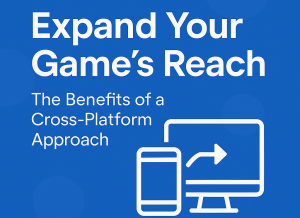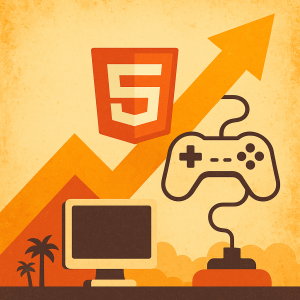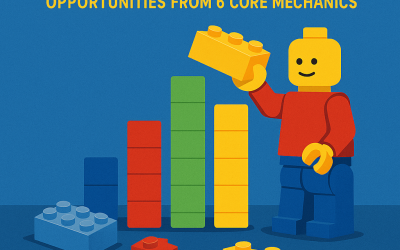Expand Your Game’s Reach: the Benefits of A Cross-Platform Approch
The mobile gaming landscape is undergoing a fundamental shift. While the app stores once offered a clear path to success, today’s developers face mounting challenges: skyrocketing user acquisition costs, intense competition, and platform fees that eat into margins. The solution? Cross-platform expansion.
As players increasingly expect seamless access across devices—starting a game on mobile during their commute and picking up where they left off on desktop at home—developers who remain app-only are leaving revenue on the table. Enter Web Playables: browser-based versions of mobile games that require no download, no install, and no friction. This isn’t just a trend. It’s a strategic response to market realities, and developers who embrace Web Playables are seeing measurable results: expanded audiences, increased engagement, and diversified revenue streams through new monetization channels including rewarded video ads, offerwalls, and optimized ad placements.
Contents
- 1 The Changing Landscape of Mobile Game Monetization
- 2 What Are Web Playables?
- 3 The Business Case: Why Developers Go Cross-Platform
- 4 Monetization Opportunities in Web Playables
- 5 Technical Advantages of Web Playables
- 6 Real Results: Performance Metrics that Matter
- 7 Why Platforms Like Pley Make Cross-Platform Expansion Easy
- 8 AppLixir Monetization Summary
The Changing Landscape of Mobile Game Monetization
The golden age of easy mobile game monetization is over. What worked five years ago no longer delivers the same returns.
The challenges are clear:
User acquisition costs have exploded. What once cost $2 per install now often exceeds $5-10, depending on your category. The app stores are saturated with millions of titles, making organic discovery nearly impossible for all but the top-ranked games. Competition for player attention has never been fiercer.
These pressures force developers to seek new monetization opportunities beyond traditional in-app purchases and standard ad placements. Web Playables represent a fresh channel—one that bypasses app store gatekeepers entirely and opens doors to web-specific monetization models that complement mobile strategies. Through Web Playables, developers can tap into rewarded video ads with higher engagement rates, implement offerwalls that convert better in browser environments, and access web traffic acquisition channels that cost significantly less than mobile app install campaigns. The question isn’t whether to expand to web—it’s how quickly you can execute.
What Are Web Playables?
Web Playables are browser-based versions of mobile games that players can access instantly through a URL. No app store visit, no download, no storage requirements, and no permission requests. Just click and play. Unlike native apps that require installation and regular updates, Web Playables run directly in modern browsers using technologies like HTML5 and WebGL. Players get immediate gratification—the game loads in seconds, and they’re playing almost instantly.
For users, the benefits are compelling:
They can try a game without commitment, play on any device with a browser, avoid cluttering their device storage, and experience your game on desktop, tablet, or mobile interchangeably.
From a monetization perspective, Web Playables shine because they support the same revenue models that work in mobile apps—rewarded video ads, interstitial ads, offerwalls, and in-app purchases—while opening additional opportunities specific to web environments. Browser-based gameplay naturally lends itself to higher rewarded video opt-in rates, as players perceive web experiences as more casual and exploratory, making them more willing to engage with incentivized ad formats.
The Business Case: Why Developers Go Cross-Platform
Expand Audience Reach
App stores create friction. Every step between discovery and gameplay represents potential player drop-off: finding your game in search, reading the description, checking the file size, waiting for download, granting permissions, and finally launching the app.
Web Playables eliminate this friction entirely. A player clicks a link in social media, a gaming portal, or a search result and starts playing within seconds. This frictionless access dramatically expands your addressable audience. You reach players who would never download an app but are happy to try a web game. You capture users on work computers or school devices where app installations are restricted. You appear in web search results alongside your app store listings, multiplying discovery opportunities.
The impact on installs is equally valuable. Web Playables function as extended demos—players experience your game risk-free, and those who love it convert to app downloads at higher rates because they’re already invested. This try-before-you-install model turns your web version into a powerful acquisition funnel for your mobile app.
Increase Playtime and Engagement
The data tells a compelling story: developers implementing Web Playables see an average of 2.5X increased playtime compared to their mobile-only strategy.
Why do web players stay longer? Accessibility plays a huge role. Players engage during moments when pulling out their phone feels inappropriate—during work breaks on desktop, while browsing on tablets, or when their phone is charging. Each of these micro-sessions adds to total playtime.
The lower commitment threshold also drives engagement. Without the psychological barrier of an app install, players feel more comfortable diving into longer sessions. They’re exploring, not committing, which paradoxically leads to deeper engagement. This increased playtime directly translates to monetization gains. More playtime means more opportunities for rewarded video ads, higher overall ad impressions, and improved eCPM as players who engage longer are more valuable to advertisers. Developers consistently report that web players generate comparable or higher ARPDAU than their mobile counterparts, despite initial assumptions that web would cannibalize premium users.
Lower User Acquisition Costs
Here’s where Web Playables deliver immediate ROI: user acquisition costs drop by an average of 50% compared to mobile app install campaigns. The economics are straightforward. Web traffic is cheaper to acquire than app installs because you’re optimizing for clicks and engagement rather than completed installations. You’re competing in a different auction with different participants, often securing traffic at CPCs far below mobile CPI rates.
Web funnels also outperform because they’re more efficient. In mobile acquisition, you pay for every install, including users who download your app and never open it. With web, you only invest in players who actually engage with your game. This fundamental difference means your acquisition budget stretches further and targets higher-intent users.
The strategic implication is powerful: you can reinvest savings into scaling your web acquisition, building a self-sustaining growth loop that feeds both your web audience and your mobile app conversions.
Reduce Platform Fees
App stores take a substantial cut—typically 30% of all revenue generated through their platforms. For developers operating on thin margins, this commission represents a significant drag on profitability.
Web Playables bypass this entirely. Transactions and monetization happen outside app store control, letting you recapture the 20% in fees you’d otherwise lose to platform commissions. While web payment processing has its own costs, they’re typically far lower—often 3-5% for payment processors.
This difference compounds over time. A game generating $100,000 monthly through in-app purchases pays $30,000 to the app store. That same revenue through web might incur $5,000 in processing fees, leaving you with $25,000 more each month to reinvest in development, marketing, or team growth. The improved margins also enhance your advertising revenue. Whether you’re running rewarded videos, interstitials, or native ads, keeping more of each dollar earned accelerates your path to profitability and sustainable operations.
Monetization Opportunities in Web Playables
Rewarded Video Ads for Web Games
Rewarded video ads have become the gold standard for free-to-play monetization, and they perform exceptionally well in web environments—often better than in mobile apps.
The browser context creates a mindset shift. Players perceive web games as casual, exploratory experiences where watching an ad for rewards feels like a fair exchange rather than an interruption. This perception drives higher opt-in rates, with many developers reporting that 60-80% of web players engage with rewarded videos compared to 40-50% in mobile apps.
User sentiment is measurably better too. Because web players haven’t invested the psychological commitment of an app download, they’re more patient with ad-supported models. They understand the value exchange—their time for premium content or in-game currency—and engage willingly. This improved engagement directly impacts your metrics. Higher opt-in rates increase total ad impressions, which raises overall CPM and eCPM. Your ARPDAU climbs as more players monetize through ads, and your retention improves because players who engage with rewarded videos tend to stick around longer, creating compounding value over their lifetime.
Offerwalls and Incentivized Ads
Offerwalls complement rewarded videos beautifully in web environments. These ad units present players with multiple offers—complete a survey, try another game, sign up for a service—in exchange for substantial in-game rewards.
Browser-based offerwalls convert particularly well because desktop and tablet screens provide more space to showcase offers attractively, players on web often have more time for longer engagement like surveys or trials, and the ability to open offers in new tabs streamlines the completion process. From a monetization perspective, offerwalls generate higher payouts per engagement than standard video ads. While a rewarded video might earn $0.01-0.05 per view, a completed offerwall action can generate $0.50-5.00 or more. For players who engage with offerwalls, LTV can spike dramatically.
The key is implementation. Offerwalls work best when positioned as premium rewards—”Complete offers to earn 10X more currency”—rather than mandatory interruptions. This approach maintains positive player sentiment while opening a high-value monetization channel that significantly improves your free-to-play economics.
Ad Revenue Optimization
Web Playables allow you to leverage the full spectrum of programmatic advertising tools to maximize revenue. By integrating with multiple ad exchanges and demand-side platforms, you create competition for your ad inventory. More bidders mean higher CPMs, as advertisers compete in real-time auctions for access to your players. This programmatic approach typically increases ad revenue by 20-40% compared to direct deals alone.
Sophisticated monetization platforms make this accessible even for smaller studios. These platforms handle the technical integration with dozens of ad networks, implement smart mediation to maximize fill rate and eCPM, provide analytics showing which networks perform best for your audience, and offer tools like ad revenue calculators to project earnings based on your traffic.
The optimization process is iterative. You test different ad placements, frequencies, and formats to find the sweet spot between revenue and player experience. Web’s faster deployment cycle—no app store approvals required—means you can iterate quickly, implementing learnings and improving monetization week over week. Smart developers also layer multiple ad formats strategically: rewarded videos for engaged players who want to earn rewards, interstitials at natural break points like level completions, banner ads for persistent, low-impact monetization, and offerwalls for highly engaged users seeking maximum rewards.
This diversified approach maximizes revenue while maintaining player satisfaction, as you’re monetizing different player segments through their preferred formats.
Technical Advantages of Web Playables
Faster Development and Deployment
One of Web Playables’ most underrated advantages is speed. When you want to test a new feature, monetization strategy, or game balance change, you simply deploy it. No app store submission, no review process, no waiting.
This agility transforms how you operate. You can run A/B tests on monetization strategies in real-time, rolling new ad placements or reward structures to segments of your audience and measuring results within hours. You can respond to player feedback immediately, addressing issues or implementing requested features the same day. You can optimize continuously, making incremental improvements that compound over weeks and months.
For monetization specifically, this speed is invaluable. You discover that rewarded videos perform better at level 5 than level 3? Deploy the change immediately. You find that Tuesday afternoon players have higher eCPMs? Adjust your ad frequency for those time windows. This level of responsiveness is impossible with app store approval delays.
Unity Monetization and WebGL Ads
Unity developers have a particularly smooth path to Web Playables thanks to WebGL export capabilities built directly into the engine. Unity games compile to WebGL with minimal code changes, typically requiring just optimization passes to reduce load times and ensure smooth frame rates. Once exported, your Unity game runs in browsers with feature parity to the mobile version, supporting the same monetization integrations.
The Unity ecosystem’s maturity means most rewarded video SDKs now support WebGL implementations. You integrate once, and your rewarded videos, interstitials, and other ad formats work across mobile and web. This reduces development overhead while ensuring consistent monetization experiences for players regardless of platform. Unity’s Asset Store also offers web-specific monetization tools, including optimized ad integration packages, analytics SDKs that track web-specific metrics, and conversion tracking to measure how web players funnel into app downloads.
For studios already building in Unity, web expansion becomes a relatively straightforward technical lift with substantial upside.
HTML5 Game Monetization
For HTML5 developers, web is your native environment. You’re already building for browsers, which means expansion to Web Playables is primarily about distribution and monetization rather than technical porting. Best practices for HTML5 game monetization center on lightweight ad integrations that don’t impact load times, smart ad mediation to maximize CPMs across networks, and thoughtful placement strategies that respect player flow.
The HTML5 ecosystem offers robust monetization solutions specifically designed for browser games. These include specialized HTML5 ad SDKs with optimized performance, analytics platforms tracking web-specific metrics like time-on-site and session depth, and payment providers optimized for browser-based transactions.
When monetizing website ads within HTML5 games, focus on formats that feel native to the web experience. Pre-roll ads before gameplay, rewarded videos integrated into game mechanics, and contextual display ads during natural pauses all work well when implemented thoughtfully.
Real Results: Performance Metrics that Matter
Numbers tell the story of Web Playables’ impact better than any theory. Developers who’ve implemented Web Playables report 2.5 million hours played across their web versions—representing massive engagement that wouldn’t exist without cross-platform expansion. These aren’t hours cannibalized from mobile; they’re incremental engagement from new players, new contexts, and new discovery channels.
The combined effect on key metrics is substantial. Playtime increases by 2.5X on average as players engage across multiple platforms and contexts. Revenue grows not just from new players but from existing players who spend more time in your game and engage more frequently with monetization opportunities. User acquisition costs drop by 50% as web traffic provides cheaper, higher-intent users who supplement your mobile acquisition strategy.
These metrics translate directly into sustainable game monetization models. The unit economics improve across the board—lower CAC, higher LTV, better margins—creating a foundation for long-term growth. Perhaps most importantly, developers report that web and mobile versions create a virtuous cycle. Web players who love your game download the mobile app for on-the-go play. Mobile players who hit device storage limits continue playing on desktop. This cross-pollination increases total lifetime value per player while reducing your dependence on any single platform.
Why Platforms Like Pley Make Cross-Platform Expansion Easy
While the business case for Web Playables is clear, execution can feel daunting—especially for teams focused on game development rather than web infrastructure. This is where platforms like Pley provide leverage. Rather than building web deployment infrastructure from scratch, Pley offers turnkey solutions that handle the technical complexity of bringing mobile games to browsers.
The platform manages the heavy lifting: seamless setup that converts your mobile game to web in days not months, integrated monetization tools including rewarded video SDKs optimized for web, distribution channels that connect your game with web traffic sources, and analytics dashboards tracking web-specific metrics alongside your mobile data. For monetization specifically, Pley’s rewarded video SDK is pre-integrated with major ad networks, ensuring high fill rates and competitive eCPMs from day one. The platform handles ad mediation automatically, ensuring you’re always serving the highest-paying ads available.
Beyond deployment and monetization, Pley provides the distribution piece many developers overlook. The platform’s gaming portal drives traffic to your web game, provides featuring opportunities for quality titles, and offers promotional tools to amplify your own marketing efforts. This comprehensive approach means you can focus on what you do best—creating great games—while Pley handles the infrastructure required to expand your reach and monetization across platforms.
AppLixir Monetization Summary
Cross-platform distribution isn’t optional anymore; it’s a competitive necessity. The developers winning in today’s market are those who meet players where they are—on mobile, on web, across devices and contexts. Web Playables represent the future of game monetization. As web technologies improve, browser capabilities expand, and players become more comfortable with browser-based gaming, the opportunity will only grow. The infrastructure is mature, the business model is proven, and the results speak for themselves.
Web monetization and mobile game ads complement each other rather than compete. Your mobile app remains your core product, but your web version becomes a powerful acquisition funnel, engagement driver, and revenue diversifier that makes your overall business more resilient. Now is the best time to expand your mobile game to the web. The technical barriers are lower than ever, platforms make deployment straightforward, and players are ready for frictionless, cross-platform experiences.
The question isn’t whether to go cross-platform—it’s whether you can afford not to. Your competitors are expanding. Your players expect it. And the economics strongly favor early movers who claim web distribution before competition intensifies. Expand your game’s reach. Diversify your monetization. Build a sustainable, cross-platform gaming business that thrives regardless of any single platform’s policies or economics.
The web is waiting. Your players are ready. And the results prove that Web Playables deliver real, measurable value for developers willing to embrace the future of game distribution.


